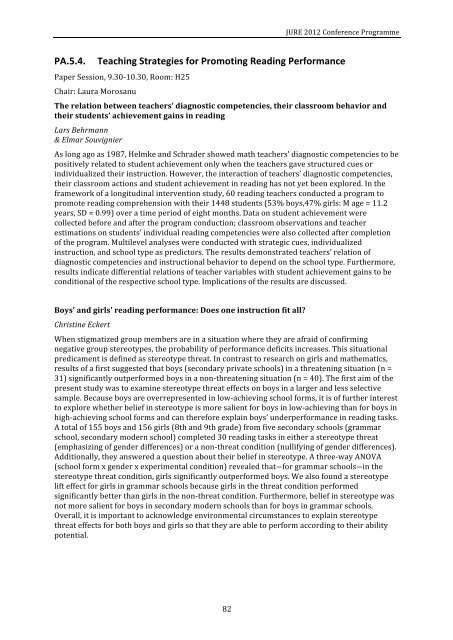JURE 2012 Programme book - EARLI Jure 2012
JURE 2012 Programme book - EARLI Jure 2012
JURE 2012 Programme book - EARLI Jure 2012
Create successful ePaper yourself
Turn your PDF publications into a flip-book with our unique Google optimized e-Paper software.
82<br />
<strong>JURE</strong> <strong>2012</strong> Conference <strong>Programme</strong><br />
PA.5.4. Teaching Strategies for Promoting Reading Performance<br />
Paper Session, 9.30-‐10.30, Room: H25<br />
Chair: Laura Morosanu<br />
The relation between teachers’ diagnostic competencies, their classroom behavior and<br />
their students’ achievement gains in reading<br />
Lars Behrmann<br />
& Elmar Souvignier<br />
As long ago as 1987, Helmke and Schrader showed math teachers’ diagnostic competencies to be<br />
positively related to student achievement only when the teachers gave structured cues or<br />
individualized their instruction. However, the interaction of teachers’ diagnostic competencies,<br />
their classroom actions and student achievement in reading has not yet been explored. In the<br />
framework of a longitudinal intervention study, 60 reading teachers conducted a program to<br />
promote reading comprehension with their 1448 students (53% boys,47% girls: M age = 11.2<br />
years, SD = 0.99) over a time period of eight months. Data on student achievement were<br />
collected before and after the program conduction; classroom observations and teacher<br />
estimations on students’ individual reading competencies were also collected after completion<br />
of the program. Multilevel analyses were conducted with strategic cues, individualized<br />
instruction, and school type as predictors. The results demonstrated teachers’ relation of<br />
diagnostic competencies and instructional behavior to depend on the school type. Furthermore,<br />
results indicate differential relations of teacher variables with student achievement gains to be<br />
conditional of the respective school type. Implications of the results are discussed.<br />
Boys' and girls' reading performance: Does one instruction fit all?<br />
Christine Eckert<br />
When stigmatized group members are in a situation where they are afraid of confirming<br />
negative group stereotypes, the probability of performance deficits increases. This situational<br />
predicament is defined as stereotype threat. In contrast to research on girls and mathematics,<br />
results of a first suggested that boys (secondary private schools) in a threatening situation (n =<br />
31) significantly outperformed boys in a non-‐threatening situation (n = 40). The first aim of the<br />
present study was to examine stereotype threat effects on boys in a larger and less selective<br />
sample. Because boys are overrepresented in low-‐achieving school forms, it is of further interest<br />
to explore whether belief in stereotype is more salient for boys in low-‐achieving than for boys in<br />
high-‐achieving school forms and can therefore explain boys’ underperformance in reading tasks.<br />
A total of 155 boys and 156 girls (8th and 9th grade) from five secondary schools (grammar<br />
school, secondary modern school) completed 30 reading tasks in either a stereotype threat<br />
(emphasizing of gender differences) or a non-‐threat condition (nullifying of gender differences).<br />
Additionally, they answered a question about their belief in stereotype. A three-‐way ANOVA<br />
(school form x gender x experimental condition) revealed that―for grammar schools―in the<br />
stereotype threat condition, girls significantly outperformed boys. We also found a stereotype<br />
lift effect for girls in grammar schools because girls in the threat condition performed<br />
significantly better than girls in the non-‐threat condition. Furthermore, belief in stereotype was<br />
not more salient for boys in secondary modern schools than for boys in grammar schools.<br />
Overall, it is important to acknowledge environmental circumstances to explain stereotype<br />
threat effects for both boys and girls so that they are able to perform according to their ability<br />
potential.



